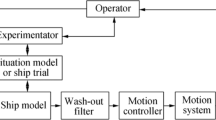Abstract
The cause and effect relationship between the paddling motion and the hull behavior of a kayak in a sprint race has not been sufficiently investigated. The objective of this study was to investigate the effect of the paddling motion on the hull behavior by numerical simulation. A dynamic simulation model of a paddler, paddle and hull in a single kayak, which was previously developed, was used for the simulation. One standard paddling motion and three modified motions were prepared for the simulation. Three modified motions were created based on suggestions by coaches of the Japan Olympic team. These motions were thought to be often seen in paddlers of lower skill level and, therefore, empirically considered to be typically bad motions. From the simulation results, the following findings were obtained: in the simulation of the standard paddling motion, the averaged hull velocity was 5.4 m/s. This was consistent with the actual hull velocity of 5.5 m/s. Typically bad motions which induced undesirable hull fluctuations reduced the propulsive efficiency.






Similar content being viewed by others
References
Mann R, Kearney JT (1983) Biomechanics of canoeing and kayaking. In: Scientific proceedings of the 1st international symposium on biomechanics in sports, pp 145–151
Baker J, Rath D, Sanders R (2010) A three-dimensional analysis of male and female elite sprint kayak paddles. In: ISBS-conference proceedings archive, pp 53–56
Kendal SJ, Sanders RH (1992) The technique of elite flatwater kayak paddlers using the wing paddle. Int J Sport Biomech 8(3):223–250
López CL, Serna JR (2011) Quantitative analysis of kayak paddling technique: definition of an optimal stroke profile. Revista Andaluza de Medicina del Deporte 4(3):91–95
Sumner D, Sprigings EJ, Bugg JD (2003) Fluid forces on kayak paddle blades of different design. Sports Eng 6(1):11–19
Jackson PS, Locke N, Brown P (1992) The hydrodynamics of paddle propulsion. In: Proceedings of the 11th Australasian fluid mechanics conference, pp 1197–1200
Aitken DA, Neal RJ (1992) An on-water analysis system for quantifying stroke force characteristics during kayak events. Int J Sport Biomech 8:165–173
Gomes B, Viriato N, Sanders R (2011) Analysis of the on-water paddling force profile of an elite kayaker. In: ISBS-conference proceedings archive, pp 259–262
Nakashima M, Yamazaki S, Yue J, Nakagaki K (2014) Simulation analysis of paddling motions in a single kayak: development of a comprehensive dynamic model of a paddler, paddle and hull. J Sports Eng Tech 228(4):259–269
Nakashima M, Satou K, Miura Y (2007) Development of swimming human simulation model considering rigid body dynamics and unsteady fluid force for whole body. J Fluid Sci Tech 2(1):56–67
Nakashima M, Kitazawa A, Nakagaki K, Onoto N, Hakamada N, Ikeda T (2015) Simulation analysis of paddling motion in a single kayak for sprint racing. In: Abstracts of 15th international symposium on computer simulation in biomechanics, pp 17–18
Wang H, Xie Y, Liu J, Zou Z, He W (2011) Experimental and numerical study of hydrodynamic forces on ship in oblique motion. In: Proceedings of the international conference in remote sensing, environment and transportation engineering (RSETE), pp 328–331
Author information
Authors and Affiliations
Corresponding author
Ethics declarations
Conflict of interest
The authors declare that they have no conflict of interest.
Rights and permissions
About this article
Cite this article
Nakashima, M., Kitazawa, A., Nakagaki, K. et al. Simulation to clarify the effect of paddling motion on the hull behavior of a single kayak in a sprint race. Sports Eng 20, 133–139 (2017). https://doi.org/10.1007/s12283-016-0222-x
Published:
Issue Date:
DOI: https://doi.org/10.1007/s12283-016-0222-x




